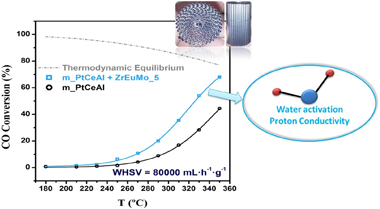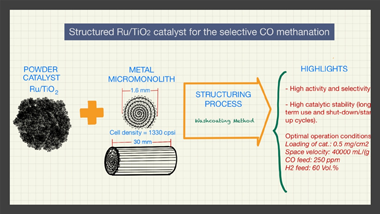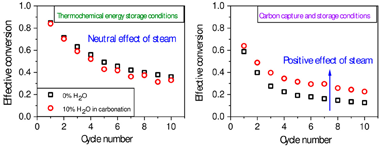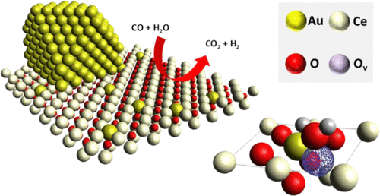Scientific Papers in SCI
2022
2022
Química de Superficies y Catálisis
Boosting water activation determining-step in WGS reaction on structured catalyst by Mo-doping
Garcia-Moncada, N; Jurado, L; Martinez-Tejada, LM; Romero-Sarria, F; Odriozola, JACatalysis Today, 383 (2022) 193-204
Show abstract ▽

Proton conductors Mo-Eu-Zr mixed oxide systems were synthesized and further mixed with a conventional Pt/CeO2/Al2O3 catalyst to develop a highly efficient water-gas-shift (WGS) catalyst. The designed catalyst, once structured, allows reach the equilibrium conversion at medium temperatures (similar to 350 degrees C) at 80 L.g(-1) h(-1) space velocity. The ability of the proton conductor to maintain an elevated water concentration at the metal-support interface by Grotthuss' mechanism boosts the catalytic activity in WGS reaction.
The Mo-containing proton conductor is extensively characterized allowing to establish the formation of molybdenum oxide phases nucleating on top of the Eu sites in Eu-Zr oxide solid solution. [MoO4](2-) to [Mo7O24](6-) clusters nucleates at low Mo contents resulting in a alpha-MoO3 layer on increasing its content. In presence of H-2, Mobronzes are formed from similar to 200 degrees C enhancing water concentration at the surfaces and boosting the catalytic activity in the WGS reaction. These results pave the way for developing lower volume WGS reactors.
January, 2022 | DOI: 10.1016/j.cattod.2020.06.003
Reactividad de Sólidos
Flash Sintering Research Perspective: A Bibliometric Analysis
Gil-Gonzalez, E; Perez-Maqueda, LA; Sanchez-Jimenez, PE; Perejon, AMaterials, 15 (2022) 416
Show abstract ▽
Flash Sintering (FS), a relatively new Field-Assisted Sintering Technique (FAST) for ceramic processing, was proposed for the first time in 2010 by Prof. Rishi Raj's group from the University of Colorado at Boulder. It quickly grabbed the attention of the scientific community and since then, the field has rapidly evolved, constituting a true milestone in materials processing with the number of publications growing year by year. Moreover, nowadays, there is already a scientific community devoted to FS. In this work, a general picture of the scientific landscape of FS is drawn by bibliometric analysis. The target sources, the most relevant documents, hot and trending topics as well as the social networking of FS are unveiled. A separate bibliometric analysis is also provided for Reaction or Reactive Flash Sintering (RFS), where not only the sintering, but also the synthesis is merged into a single step. To the best of our knowledge, this is the first study of this nature carried out in this field of research and it can constitute a useful tool for researchers to be quickly updated with FS as well as to strategize future research and publishing approaches.
January, 2022 | DOI: 10.3390/ma15020416
Química de Superficies y Catálisis
Metal micromonoliths for the cleaning of H-2 by means of methanation reactions
Laguna, OH; Munoz-Murillo, A; Bobadilla, LF; Martinez, LM; Montes, M; Centeno, MA; Odriozola, JACatalysis Today, 383 (2022) 216-225
Show abstract ▽

The present manuscript presents for the first time the structuring of a Ru/TiO2 catalyst that was achieved by means of the washcoating procedure using homemade metal micromonoliths (Fecralloy (R)) of 1330 cpsi. For this, an optimized formulation of the slurried catalyst as well as a reproducible protocol for the coating of the micromonoliths were successfully achieved. The obtained structured systems were tested in the selective CO methanation reaction and the effect of different variables over the catalytic performance were analyzed such as the amount of loaded catalyst in the micromonoliths, the temperature of reaction, the space velocity, and the amount of CO and H-2 within the feed-stream. The study of all of these parameters allowed to establish optimal conditions to maximize the performance of the structured Ru/TiO2 catalyst and subsequently, this was tested under those cited conditions in long-term tests (similar to 375 h), including shut-down/start-up cycles, aiming to evaluate its catalytic stability. The system presented a considerable stability along the different test without loss of catalytic activity, being specially remarkable its resistance to the inclusion of shut-down/start-up cycles. Therefore, this study lays the foundations for future development of more sophisticated structured systems for the selective CO methanation based on the structuring strategy proposed.
January, 2022 | DOI: 10.1016/j.cattod.2021.04.026
Reactividad de Sólidos
Effect of Steam Injection during Carbonation on the Multicyclic Performance of Limestone (CaCO3) under Different Calcium Looping Conditions: A Comparative Study
Troya, JJA; Moreno, V; Sánchez-Jiménez, PE; Perejon, A; Valverde, JM; Perez-Maqueda, LAACS Sustanaible Chemistry & Engineering, 10 (2022) 850-859
Show abstract ▽

This study explores the effect of steam addition during carbonation on the multicyclic performance of limestone under calcium looping conditions compatible with (i) CO2 capture from postcombustion gases (CCS) and with (ii) thermochemical energy storage (TCES). Steam injection has been proposed to improve the CO2 uptake capacity of CaO-based sorbents when the calcination and carbonation loops are carried out in CCS conditions: at moderate carbonation temperatures (similar to 650 degrees C) under low CO2 concentration (typically similar to 15% at atmospheric pressure). However, the recent proposal of calcium-looping as a TCES system for integration into concentrated solar power (CSP) plants has aroused interest in higher carbonation temperatures (similar to 800-850 degrees C) in pure CO2. Here, we show that steam benefits the multicyclic behavior in the milder conditions required for CCS. However, at the more aggressive conditions required in TCES, steam essentially has a neutral net effect as the CO2 uptake promoted by the reduced CO2 partial pressure but also is offset by the substantial steam-promoted mineralization in the high temperature range. Finally, we also demonstrate that the carbonation rate depends exclusively on the partial pressure of CO2, regardless of the diluting gas employed.
January, 2022 | DOI: 10.1021/acssuschemeng.1c06314
Química de Superficies y Catálisis
Au and Pt Remain Unoxidized on a CeO2-Based Catalyst during the Water-Gas Shift Reaction
Reina, TR; Gonzalez-Castano, M; Lopez-Flores, V; Martinez, LMT; Zitolo, A; Ivanova, S; Xu, WQ; Centeno, MA; Rodriguez, JA; Odriozola, JAJournal of the American Chemical Society, 144 (2022) 446-453
Show abstract ▽

The active forms of Au and Pt in CeO2-based catalysts for the water-gas shift (WGS) reaction are an issue that remains unclear, although it has been widely studied. On one hand, ionic species might be responsible for weakening the Ce-O bonds, thus increasing the oxygen mobility and WGS activity. On the other hand, the close contact of Au or Pt atoms with CeO2 oxygen vacancies at the metal-CeO2 interface might provide the active sites for an efficient reaction. In this work, using in situ X-ray absorption spectroscopy, we demonstrate that both Au and Pt remain unoxidized during the reaction. Remarkable differences involving the dynamics established by both species under WGS atmospheres were recognized. For the prereduced Pt catalyst, the increase of the conversion coincided with a restructuration of the Pt atoms into cuboctahedrical metallic particles without significant variations on the overall particle size. Contrary to the relatively static behavior of Pt-0, Au-0 nanoparticles exhibited a sequence of particle splitting and agglomeration while maintaining a zero oxidation state despite not being located in a metallic environment during the process. High WGS activity was obtained when Au atoms were surrounded by oxygen. The fact that Au preserves its unoxidized state indicates that the chemical interaction between Au and oxygen must be necessarily electrostatic and that such an electrostatic interaction is fundamental for a top performance in the WGS process.
January, 2022 | DOI: 10.1021/jacs.1c10481
- ‹ previous
- 60 of 410
- next ›














